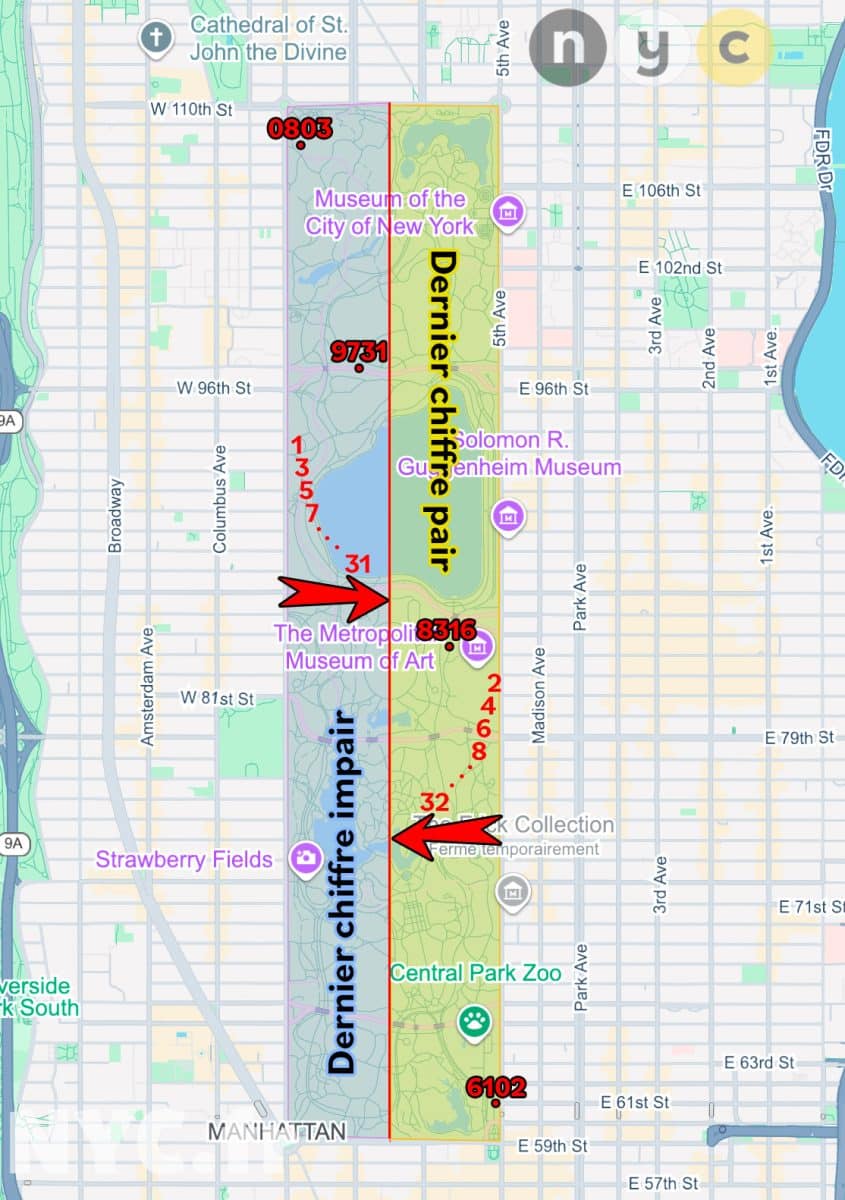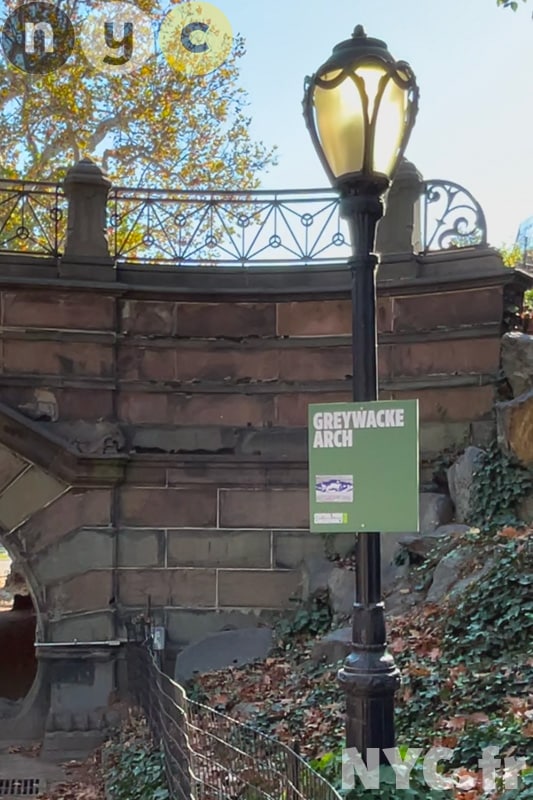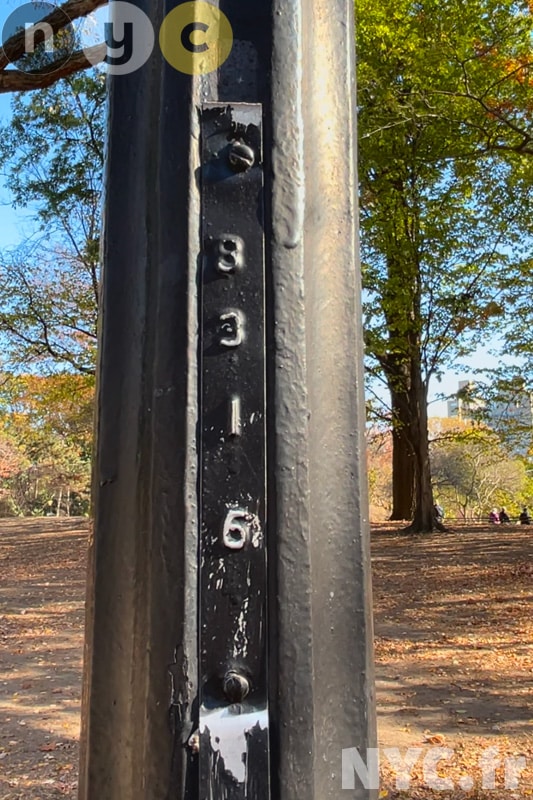Light guides in the heart of New York
The lampposts in Central Park are more than just sources of light. They are silent guides, witnesses to history and guardians of an ingenious system for navigating this immense green lung of Manhattan. To give you an idea of the size of the park, its 3.41 km² surface area is comparable to that of entire towns such as Clichy or Neuilly-sur-Seine in France. Each lamp post helps you find your way around this vast expanse of green.
A unique numbering system
Each lamp post in Central Park bears a metal plate numbered with four “secret” digits. This is not a simple identification number, but a real GPS code to help you find your way around the park. Here’s how to decipher it:
The first two numbers indicate the nearest cross-street. Central Park stretches from 59th Street to 110th Street. So if you see a lamppost starting with 59XX, you’re at the southern end of the park. If it begins with 85XX, you are aligned with 85th Street.
For streets from 100 to 110, the first two digits are 00XX to 10XX. For example, 0336 means you are at 103rd Street.
The last two numbers indicate your east-west position and distance from the edge of the park:
- An even number means you are on the east side of the park, towards 5th Avenue (yellow zone on the map).
- An odd number indicates the west side, towards Central Park West (blue zone on the map below).
- The smaller the number (XX02, XX04…), the closer you are to the park exists.
- The larger the number (XX32, XX34), the closer you are to the centre of the park (red line on the map).

For example, lamppost 9731 indicates that you are on the west side of the park (blue zone), aligned with 97th Street, and fairly close to the centre (red line). On the other hand, 6102 puts you on the east side, at 61st Street, but closer to 5th Avenue (park exit).
The story behind the lampposts
The lampposts you see today are the result of a long evolution and debate about the historic preservation of the park. The original lampposts were designed in 1910 by Henry Bacon, the architect of the Lincoln Memorial. Although the poles survived, the original lights proved fragile and were completely replaced by 1940.
In the 1980s, a renovation project was launched. Designers Gerald Allen and Kent Bloomer worked for nine months to create a new design that would respect the original spirit while being more durable. Their inspiration? Nature itself. Bacon ‘s floor lamps already featured botanical elements such as seeds, leaves and a trunk. Allen and Bloomer decided to complete this metaphor by creating a luminaire that would resemble a flower blooming at the top of the floor lamp.
A design combining tradition and modernity
The design process was meticulous and iterative. The designers had to strike a balance between the abstract and the figurative, the historic and the contemporary. After several proposals and adjustments, the final design was approved in June 1981. It features four loops forming the base of a bud, with small leaves attached, creating a basket of light that is both energetic and graceful.

These new floor lamps are not just aesthetically pleasing. They are made from high-strength aluminium to resist vandalism. The bulbs use halide metal, giving a fresher, whiter light than the sodium vapour lamps originally planned. This project, completed in 1996, saw the installation of 1,200 new lampposts along the park’s 53 kilometres of paths, considerably improving night-time safety.
Tips for your walk
Now that you know the secret of Central Park‘s lampposts, here are a few tips on how to make the most of them during your visit:

So what do you think? North/south, east/west?
- Orientation game: use the numbers on the lampposts as a game to help you find your way around the park. Try to guess where you are before checking your map.
- Historical walk: look at the details of the lampposts. The leaf and branch patterns are a tribute to the original 1910 design. It’s a bit of history you can touch!
- Unique photo: take a photo of a lamppost with its number visible. It’s an original souvenir and a way of remembering exactly where you were in the park.
- Night-time exploration: the lampposts really come into their own at night. Their white light creates a magical atmosphere. Don’t hesitate to take an evening stroll to appreciate their beauty (while remaining cautious, of course).
- Meeting point: if you’re visiting the park in a group, use the numbers on the lampposts as precise meeting points. It’s much easier than saying “by the big tree”!
The must-see areas of Central Park
Now that you know how to find your way around thanks to the lampposts, here are a few areas not to be missed during your visit:
- Bethesda Terrace and Fountain (lampposts 72xx): At the heart of the park, this is an iconic spot with its magnificent fountain and view over the lake.
- Belvedere Castle (lampposts 79xx): This miniature castle offers a panoramic view of the park and the town.
- Strawberry Fields (lampposts 72xx): A memorial to John Lennon, located close to where he lived.
- The Mall and Literary Walk (lampposts 66xx to 72xx): A beautiful avenue lined with elm trees and statues of famous writers.
- Conservatory Water (lampposts 74xx): A small lake where New Yorkers sail remote-controlled miniature boats.
Central Park ‘s lampposts are much more than just sources of light. They are the silent guardians of an ingenious system that allows you to navigate this vast green space. On your next visit, take the time to observe these metal sentinels. They will tell you the story of the park, guide you in your explorations and add an extra dimension to your Central Park experience. Enjoy your walk!

